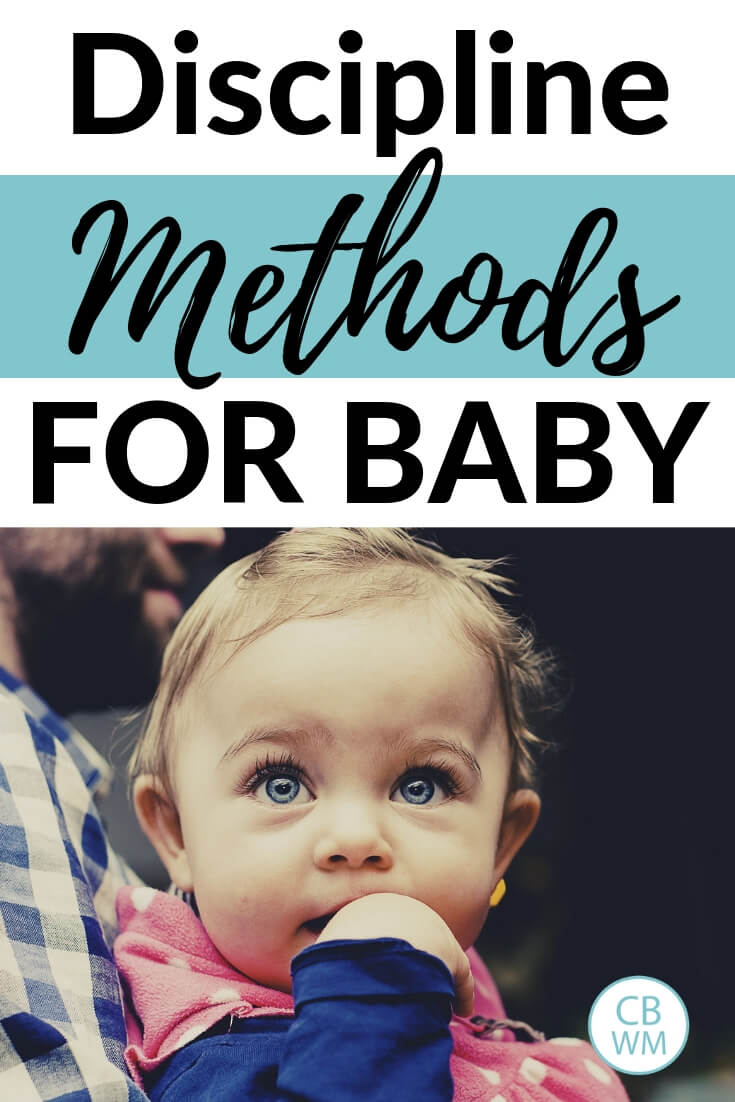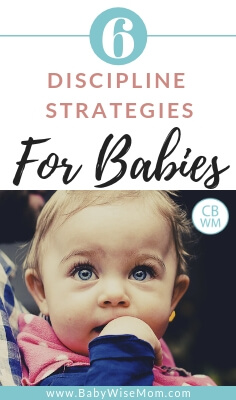Discipline Methods for Baby: 10 Months and up. Different ways to help teach baby what is okay and what isn’t okay to do. Babies can learn!

Babies are adorable. They are so cute and do the cutest things. But babies aren’t just cuteness. They are also very smart. Babies can learn more than we often give them credit for. When a baby does something we do not want baby doing, we don’t have to just allow it. We can actually correct it! Remember you can give your baby rules and boundaries.
If change in behavior does not happen, your discipline method is ineffective. By discipline I simply mean correction. Your aim is to teach the baby what is not okay and what is okay instead. If you try one method and things do not change, try a different method.
Post Contents
Discipline Strategies for Babies
There are a lot of different discipline methods you can do to correct a baby or young toddler when they are doing something they shouldn’t. Here are a few ideas.
Verbal Correction
This is something you can start using sooner than 10 months old. This is my method of choice for all ages. I use it with my children. For this to work, your child has to obey your voice. He will have times when he absolutely just ignores you. Many times, he does this to test if you mean it.
You will also find that he obeys well, then will start ignoring you again. This usually accompanies a new skill. One example is when he starts to climb the stairs by himself. Part of his choice to ignore you is his strong desire to climb those stairs over and over to practice. There are ideas in On Becoming Toddlerwise for addressing situations like this. See How to Use Substitution for Discipline. Another part of his choice to ignore you is that his new skill has brought with it new freedoms. He needs to test his limits of those freedoms.
Don’t underestimate the power of verbal correction. As I said, it is what I use the vast majority of the time for all ages thus far (Brayden is approaching 14 years old). I used this primarily with my kids when they were babies.
We aren’t special around here; it can work for you, too. Part of our success is that I use it from the beginning. For the entire span of my children’s lives, I have been correcting them verbally. Another part is that I expect them to obey that verbal direction. Children live up to expectations.
When Kaitlyn was close to two, I noticed that even Kaitlyn obeyed her brothers “verbal direction” above the percentages expected for her age. He did not need to be giving her verbal direction, but that is a whole other topic. The point is all he did was verbally instruct her and she obeyed. He did not use any other method of persuasion to get her to listen to him.
A third reason we are successful with verbal correction is that I am very consistent. I am consistent with what is okay and what isn’t. I am consistent with providing that verbal correction. Finally, we are successful because I also offer a lot of verbal praise when they choose the right thing.
Always remember to allow your little one to Discipline Strategy: Surrender with Dignity.
Distraction
A great little tool for discipline is distraction. With this, you essentially focus your baby’s attention on something else. If she really wants to go up those stairs, you work to distract her to focus elsewhere. Read Distraction as a Discipline Tool for more.

Encouragement
Encouragement is a great discipline tool. It is positive discipline and helps you focus your child on what she should be doing rather than what not to be doing. Read more on How to Use Encouragement as a Discipline Tool here.
Isolation in the Crib
If your child refuses to listen or is emotionally out of control, you can remove him from the situation and put him in his crib (or a pack-n-play). At 10 months, you can be sure your child can easily learn cause and effect relationships. The most common worry for parents with this method of correction is that the child will start to hate the crib. Your child is smart enough to associate the difference between isolation time and sleep time. I have never heard a parent who does isolation in the crib say that their child started to hate the crib.
Read: Time Out/Isolation
Loss of Privilege
This is to reinforce verbal instruction. You use it if the child does not obey the verbal instruction you have given. This is my second most used method of correction for all ages. He can lose a privilege, a toy, etc. If he refuses to listen to your instruction to not go up the stairs, then he might lose his privilege to climb himself at appropriate times. If he throws something off the highchair, he loses it, etc.
Mommy Glare
You know. The look.
This is my own addition. In conjunction with the verbal instruction, I give them what I call my “Mommy Glare.” This is that look you give that tells your child what they are doing is inappropriate. Often times for me, just the look is enough to stop the child if he already knows what he is doing is inappropriate.
Never underestimate the power of the look. I literally have stopped a physical fight between high school boys after a basketball game with my “look.”
On Becoming Babywise II lists methods of correction appropriate for babies 10 months and up. Many of those ideas are listed here. Some of these can be used sooner than ten months old if you feel your baby can respond to it. These are found on page 60.

Discipline Methods to Avoid
Anger
Avoid getting angry. When applying these methods, remain calm and matter-of-fact. Getting angry about the situation does not help your child to obey. It also puts you and your little one at odds with each other. You can correct your child and still be on your child’s side or team when you maintain your composure and correct your child.
Emotional Manipulation
This is really along the lines of getting angry. Don’t make your child feel like he is about to lose the love of his parents because he did something wrong. Apply the consequence for the action without holding a grudge and without trying to apply a guilt trip. Again, tie no emotion to it. It just is what it is. Child did something he shouldn’t have so now he has the consequence for it.
Related Discipline Posts:
- Teaching Your Baby “No”
- Training in Times of Non-Conflict
- Controlling the Young Temper
- The “Mini-fit”
- Tips for Baby-Proofing Your Home
- Discipline: Progress is a Spiral
- Throwing/Dropping Food off of the Tray
- How to Know What Freedoms to Give Baby


